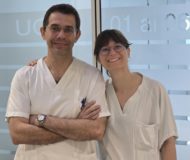

Physicians from the Intensive Care Medicine Department at Hospital Sant Pau, members of the Sant Pau Research Institute (IR Sant Pau), have participated in the international PROMIZING study. This is one of the most ambitious clinical trials to date aimed at optimizing the discontinuation of mechanical ventilation in patients with severe respiratory failure. Recently published in The New England Journal of Medicine, the study compares proportional-assist ventilation (PAV+) with pressure-support ventilation (PSV), with the goal of determining whether the former method could facilitate faster and less complicated weaning from the ventilator.
Sant Pau’s participation in the trial was significant thanks to the contribution of a team of intensivists with a strong track record in clinical research. The trial was designed and directly led by Dr. Jordi Mancebo, a leading figure in the field of mechanical ventilation and one of the driving forces behind the study from the beginning. Furthermore, by Dr. Juan Carlos Suárez, a close collaborator and also a physician in the Intensive Care Department. Sadly, both passed away before the final publication of the study and were honored by their colleagues with a special dedication at the end of the article. Also listed as coauthors of the paper are Dr. Indalecio Morán and Dr. Núria Rodríguez, active members of the hospital’s care and research team.
PROMIZING (short for Proportional Assist Ventilation for Minimizing the Duration of Mechanical Ventilation) was a prospective, multicenter, randomized study conducted across 23 hospitals in 7 countries (Canada, France, Italy, Greece, Argentina, Saudi Arabia, and Spain). The study enrolled 722 patients admitted after an episode of severe acute respiratory failure, of whom 573 were randomized. All participants were adults who had been under invasive mechanical ventilation for at least 24 hours and had failed an initial spontaneous breathing trial. They were randomized to receive spontaneous mechanical ventilation in either PAV+ or PSV mode. The primary endpoint was the time to successful liberation from the ventilator, defined as definitive discontinuation of ventilation without the need for reintubation for at least seven days.
Using the method proposed in the study to compare both modes during the weaning phase, the authors found no significant differences between PAV+ and PSV regarding the time to successful ventilator liberation. Specifically, the average time to permanent disconnection was nearly identical in the PAV+ group (7.3 days) compared to the PSV group (6.8 days), with the small difference not being statistically significant. The probability of successful liberation at 28 days was also very similar between the two groups (83.3% with PAV+ and 85.2% with PSV). Likewise, the average number of ventilator-free days during this period was 20.4 for PAV+ and 21.3 for PSV.
Regarding 90-day mortality, the results showed a rate of 29.6% in the PAV+ group and 26.6% in the PSV group, with no statistically relevant differences.
In addition to findings on ventilation duration and mortality, the study also explored factors relevant to quality of care and patient safety, such as the incidence of delirium, the cumulative use of sedatives and opioids, tolerance to the assigned ventilatory mode, and complications associated with the weaning process.
The incidence of delirium was similar between the two groups, suggesting that the ventilatory mode alone is not a determining factor in patients’ acute cognitive state. However, the study did note that patients in the PAV+ group tended to require lower cumulative doses of sedatives during the early observation period, which could suggest better synchrony between the patient and the ventilator. Despite this trend, the difference was not statistically significant. Opioid use was also tracked and compared, with no substantial differences between groups.
On the other hand, patients in the PAV+ group were switched to controlled ventilation modes more frequently than those in the PSV group. According to the authors, this may reflect both the clinical management complexity and a lower level of familiarity among staff with this strategy. Specifically regarding tolerance to the assigned mode, most patients were able to complete the intervention period in their assigned mode. However, there was a slight increase in mode changes within the PAV+ group, often due to clinical decisions related to respiratory stability or patient adaptation to the ventilator.
There were also no differences between groups in terms of complications related to the weaning process or the ventilatory mode itself, reaffirming the safety of PAV+ use in centers experienced in mechanical ventilation. While the study did not show statistically significant differences between PAV+ and PSV, it provides valuable information for better understanding the practical implications and clinical acceptability of proportional-assist ventilation.
According to Dr. Indalecio Morán, “PROMIZING provides very robust knowledge to guide decision-making during mechanical ventilation withdrawal and to further study spontaneous ventilation modes during the weaning phases, while validating the safety of proportional ventilation in centers with excellence in mechanical ventilation management.” For her part, Dr. Núria Rodríguez noted, “This study shows us that what can truly make a difference is an individualized weaning strategy applied with rigor. The ventilatory mode is a tool, but the key is how we use it within a coherent, patient-centered clinical framework.”
Bosma KJ, Burns KEA, Martin CM, Skrobik Y, Mancebo Cortés J, Mulligan S, Lafreniere-Roula M, Thorpe KE, Suárez Montero JC, Morán Chorro I, Rodríguez-Farré N, Butler R, Bentall T, Beduneau G, Enguerrand P, Santos M, Piraino T, Spadaro S, Montanaro F, Basmaji J, Campbell E, Mercat A, Beloncle FM, Carteaux G, Maraffi T, Charbonney E, Lecronier M, Dres M, Arabi YM, Amaral ACK, Marinoff N, Adhikari NKJ, Geagea A, Shin P, Vaporidi K, Kondili E, Shahin J, Campisi J, Rodriguez PO, Setten M, Goligher EC, Ferguson ND, Fanelli V, Ferreyra G, Lellouche F, Sibley S, Brochard L, PROMIZING Study Investigators, the Canadian Critical Care Trials Group, and the REVA Network. Proportional-assist ventilation for minimizing the duration of mechanical ventilation. N Engl J Med. 2025. https://doi.org/10.1056/NEJMoa2505708